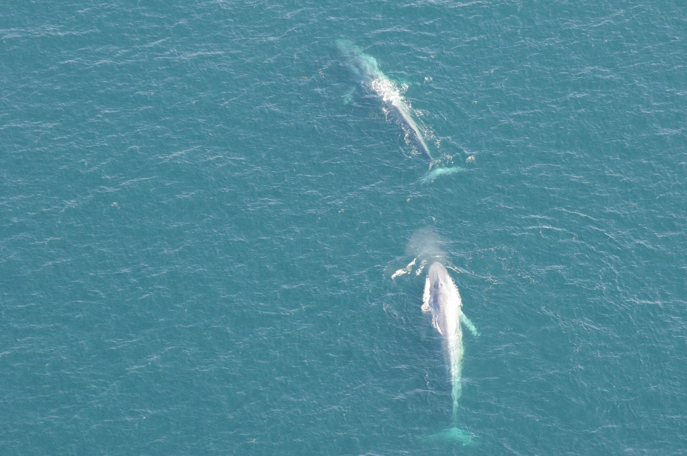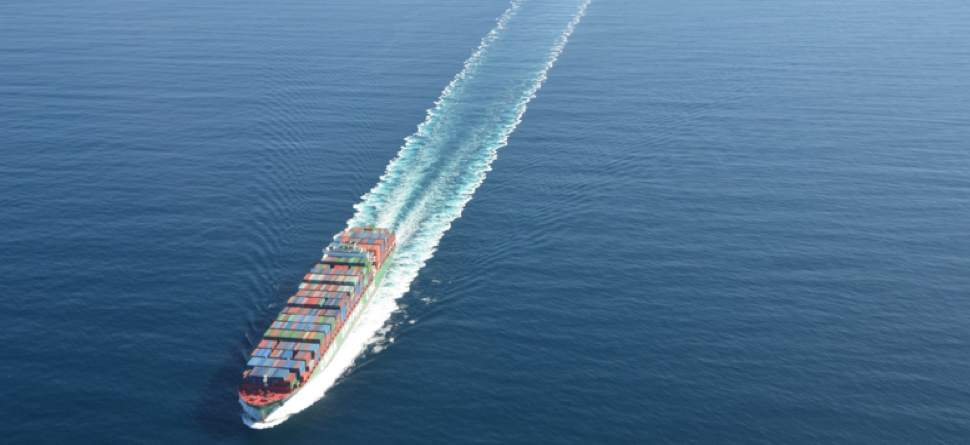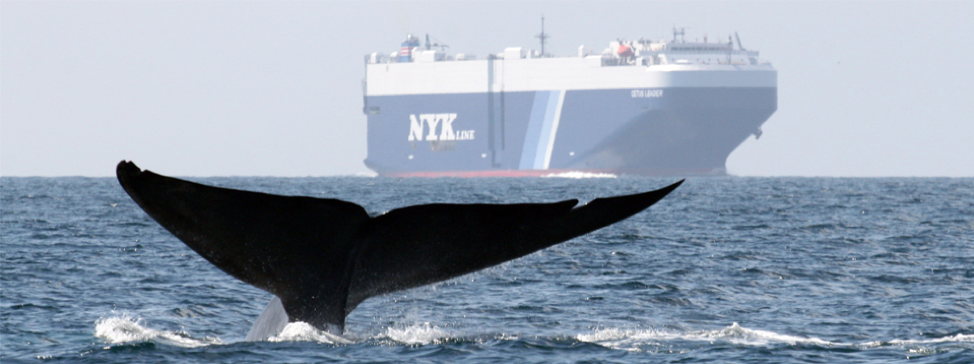
Blue whales off of Santa Cruz Island in Channel Islands National Marine Sanctuary
Photo credit: Sean Hastings/NOAA CINMS
Home to cold, blue, productive waters, the state of California is a host to many charismatic ocean species, including the largest on the planet, the elusive blue whale. Though some types of whales are spotted year round in sanctuary waters, blues and most populations of large whales typically gather in large numbers in these rich waters from May through November to feed on krill and copepods, socializing and filling their bellies with up to 2,200 pounds of small invertebrates per day. Beyond being amazing animals to bear witness to, these large aggregations of hungry giants have an important ecological impact on the communities around them and play a key role in the dynamic food webs in which they intersect.

A large container ship transiting north in the Santa Barbara Channel
Photo credit: Jessica Morten/NOAA CINMS
Also at home in California’s blue waters are another kind of ocean giant – container ships – which frequent our state’s busy ports in a steady stream in the thousands, delivering the goods and products on which we all rely. Though virtually unnoticed by the public – do most people think about the 1,200 foot container ship that carried their toothbrush? – more than 80% of global trade takes place by container at sea, making the international shipping industry a major and influential player in the global economy. Though all of this activity is a great thing for our regional economy and for the countless consumers whom these shipments serve, it can also pose serious problems for populations of whales when these shipping lanes intersect with critical feeding habitats, resulting in these fast-moving ships fatally striking and killing these federally protected animals.

A blue whale and car carrier in the Santa Barbara Channel
Photo credit: John Calambokidis/Cascadia Research
More commonly referred to as ship strikes, many efforts have been taken to explore this issue regionally and internationally.In 2014, realizing that further action was needed in the short term, the Foundation, Channel Islands National Marine Sanctuary, Environmental Defense Center, the Ventura County Air Pollution Control District and the Santa Barbara County Air Pollution Control District rolled out an unconventional pilot program to work alongside the elusive shipping industry to slow their vessels down in southern California, improving local air quality (slower ships also means fewer harmful air emissions) and reducing the risk of ship strikes on whales in this region.
Rather than mandate the shipping industry to comply with regulations, this voluntary, incentive-based program works in direct partnership with the shipping lines to achieve these air quality and conservation benefits. And, because the methods are non-regulatory, this collaborative and voluntary effort can achieve benefits right away.
Since 2014, the program, now dubbed the Protecting Blue Whales and Blue Skies Vessel Speed Reduction Program, has seen continued success and expansion, with eleven major shipping companies (CMA CGM, EVERGREEN, Hamburg Sud, Hapag Lloyd, Hyundai Merchant Marine, K Line, Maersk, Matson, MSC, NYK Ro-Ro, and Yang Ming) engaged in 2017 to ultimately slow 140 previously fast transits along the California coast. In 2016, the partnership was expanded to include the Volgenau Foundation and in 2017, it was scaled up even further to include transits in the San Francisco Bay area and incorporate great partners like Cordell Bank National Marine Sanctuary, Greater Farallones National Marine Sanctuary, Monterey Bay National Marine Sanctuary, and the Bay Area Air Quality Management District.
On March 1, 2018, at the Port of Los Angeles, the Foundation organized and hosted an Awards Ceremony event to recognize and celebrate the shipping industry participants of the 2017 program and engage them on future conservation initiatives.
And while no silver bullet solution has yet been identified to solve the issue of ship strikes, we here at the National Marine Sanctuary Foundation are heartened by the continued progress being made to engage the shipping industry on these important conservation issues. Plans for a bigger and more impactful 2018 slow down program are still underway, but engagement and interest levels within the industry and partners provide a promising foundation for future expansions. Through these collaborative efforts that maximize the power of partnerships, the forecast looks hopeful that we can continue to find ways to protect blue whales and blue skies in California for years to come.
